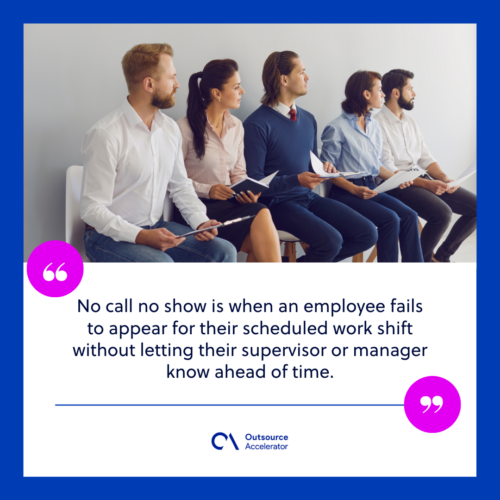No call no show: How to deal with it

It should be a common practice for employees to notify their team members or company about their absences in advance.
However, what if an employee fails to do so? The entire team gets affected as they now have to shoulder the absent employee’s workload.
This is known as a no call no show case, and it is a workplace issue that must be handled immediately.
What does no call no show mean?
No call no show is when an employee fails to appear for their scheduled work shift without letting their supervisor or manager know ahead of time.
While employees are entitled to different types of leaves, such as medical leaves or family leaves, no call no shows are unregulated absences that the employer is not made aware of.
As a result, the employer has the right to enforce their own consequences and terminate an employee if necessary.

How to deal with no call no show employees
No call no show employees must be dealt with according to the company’s guidelines. While it may differ depending on the company, there are common ways to address this issue.
Implement a strict no call no show policy
To prevent this issue from happening in the first place, employers must lay down the ground rules early on in the employee’s duration of employment.
The company’s policy must be clear about several information, such as:
- General rules of absenteeism
- Possible disciplinary actions that may be taken
- Acceptable reasons for no call no show
- How many no call no shows before termination
It is important for companies to effectively communicate these policies so that new and old employees are made aware of the consequences.
Adhering to these well-defined policies prevents issues and decreases the chances of no call no show cases.
Maintain open communication
If an employee fails to inform their supervisor of their absence, it could be because of an internal communication issue.
For example, the employee may be uncomfortable asking for time off due to personal issues. Another example is if the employer is not clear about time off policies.
This is why it is important to have an open and honest communication system where employees can freely express their concerns regarding time off.
Doing so promotes trust and transparency between both parties, allowing the employee to feel safe sharing personal information with their superior and preventing no call no show cases.
Utilize communication tools
Many workplace tools help manage employees and their absences. Applications like Slack or Clockify make it easier for employers to communicate with their team and monitor who will be absent and when.
Not only does this reduce no call no show cases, but it promotes open communication and increases workplace efficiency when keeping track of employees.
Take action immediately
No call no shows are serious work violations and must be dealt with immediately. Sweeping it under the rug will only cause more of it until employees eventually take advantage of it.
Immediate action may serve as a wake-up call for employees so they know not to repeat it. It emphasizes the importance and severity of their actions and how they affect others.
What no call no show excuses are valid?
A no call no show excuse is only valid if the employee is unable to inform their supervisor of their absence due to an emergency, such as:
- Car/vehicular accidents, especially those that result in injury
- Medical emergencies/being rushed to the hospital
- Death of a family member or loved one
These emergencies can happen at any time, so it is understandable if an employee cannot inform their employer ahead of time.
It is ultimately up to the employer to determine the validity of an employee’s excuse. Either way, the employer must be open to these situations when creating a no call no show policy.
How to create a no call no show policy
Having a clear no call no show policy helps prevent unwanted cases and keeps employees informed of the consequences. Here are the steps to creating one for your company.
Clearly define a no call no show
It all starts with stating what defines a no call no show case. Make the definition clear and easy to understand for the employees.
For example, if an employee fails to notify their supervisor via email, text message, or messaging app, it is considered a no call no show.

Be clear about valid and invalid reasons
The reason for a no call no show is often a gray area, as each case is different. That is why it is important to be clear about what constitutes a valid or invalid reason.
For example, medical emergencies are a valid reason for forgetting to inform your supervisor, but simply forgetting to is not.
Outline the consequences
Be clear about the consequences of a no call no show. Depending on the severity of each case, the employer may issue warnings or disciplinary actions to the employee in question.
Employers could issue a verbal warning on the first offense, a suspension for the second, and deem the employee eligible for termination on the third.
Addressing no call no shows professionally
No call no shows are not to be taken lightly, as they could affect a team’s overall productivity and rhythm at work. That’s why no call no show policies are more important than ever.
It is all about being clear to your employees and taking the appropriate measures to prevent them from happening again.







 Independent
Independent




